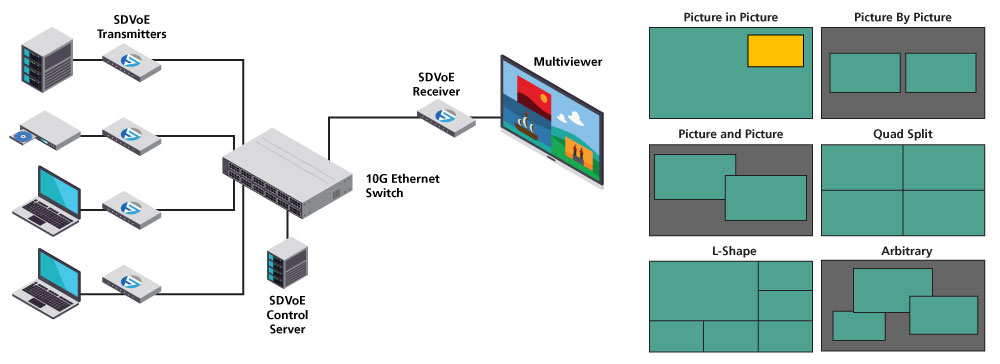Semiconductor Solutions for Multiviewers
Traditional multiviewer processors require an expensive, specialized central video processor with very high bandwidth to receive and scale multiple feeds. Semtech’s award-winning BlueRiver® technology allows distributed processing to be spread out across multiple endpoints, so no one device needs to have the full capabilities of costly video processors. The scalability makes it easy to build a custom multiviewer with exactly the right number of inputs and outputs. In the example below, the SDVoE™ Receiver is subscribing to four different video sources supplied by the four SDVoE transmitters for output on HDMI to a single display. The AVP2000 in the Receiver uses the integrated AV processing video compositing function to create a custom multiview layout. The AVP2000 can subscribe to up to 32 video sources, or to the maximum number of video streams that can be carried by a single 10G Ethernet link, for displaying in typical multiview layouts, shown below.

Figure 1. AVP2000 can subscribe to up to 32 video sources for displaying in typical multiview layouts.
Inside the Box with AVP2000: A Powerful AV-over-IP Multiviewer Solution
SDVoE Transmitters based on the AVP2000 are able to output two streams simultaneously: the native stream of the HDMI input, plus a scaled stream of that same input. For multiviewer applications, AVP2000-based Transmitters with AV processing are required in order to manage network bandwidth, by pre-scaling and/or reducing the frame rate of the source to fit the destination multiview window. For example, an SDVoE Transmitter can send a 4K60 source as a frame rate divided 4K30 stream and a 1080p60 scaled stream, since both streams fit within the 10G network bandwidth. The 4K30 stream can be subscribed to by Receivers for displaying full screen on a 4K TV, while another Receiver is configured to show the 1080p60 scaled stream as the Picture In Picture source in a multiview.
Figure 2. AVP2000-based SDVoE transmitters can output two streams simultaneously: the native stream, plus a scaled stream, of the HDMI input.
For multiviewer applications, the AVP2000 is also required in the SDVoE Receiver. The AV processing engine requires two additional DDR memory components in a typical low cost design. The devices uses the DDR memory to implement a very powerful video frame buffer, required to compose the desired multiview layouts prior to outputting to the display. The AVP2000 is shown here coupled with an SFP+ optical module for 10G fiber network connectivity. However, the AVP2000 can also be paired with a 10GBaseT PHY for 10G over copper category cables.
Figure 3. AVP2000 is paired with an SFP+ optical module for 10G fiber network connectivity in this SDVoE receiver for multiviewer applications.
Discover our semiconductor solutions for your Pro AV needs.
Multiviewer Recommended Solutions
- BlueRiver for SDVoE
- Circuit Protection
Related Resources
Videos

